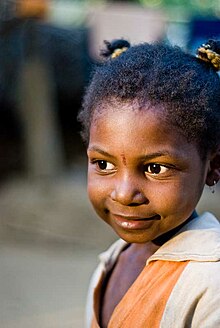|
Siddi, Sheedi, Habshi | |
| 50.000 – 60.000 (perkiraan) | |
 Pakistan Pakistan | 50.000[1] |
|---|
 India India | 25.000[2] |
|---|
| Karnataka | 10.477 (sensus 2011)[3] |
|---|
| Gujarat | 8.661[3] |
|---|
| Daman dan Diu | 193[3] |
|---|
| Goa | 183[3] |
|---|
|
| Urdu, Hindi, Balochi, Sindhi, Kannada, Gujarati, Marathi, Konkani | |
| Mayoritas: Islam (Sufi, Sunni); minoritas: Hinduisme, Kekristenan (Katolik) |
Sidi (diucapkan [sɪd̪d̪iː]), juga dikenal dengan istilah Siddhi, Sheedi, atau Habshi, adalah kelompok etnis yang tinggal di wilayahIndia dan Pakistan. Mereka merupakan keturunan suku-suku Bantu dari kawasan Danau Besar Afrika. Beberapa di antara mereka berprofesi sebagai pedagang, pelaut, hamba, budak, dan tentara bayaran.[4] Komunitas Siddi saat ini diperkirakan berjumlah 50.000-60.000 orang. Populasi mereka tersebar di Karnataka, Gujarat, dan Hyderabad di India, serta di Makran dan Karachi di Pakistan.[5][6] Kebanyakan di antara mereka beragama Sufi, walaupun beberapa menganut agama Hindu dan ada juga yang beragama Katolik.[7]
Orang Siddi pertama diduga tiba di India pada tahun 628 di pelabuhan Bharuch. Orang-orang Bantu lainnya datang setelah anak benua India diserang oleh pasukan Muslim pada tahun 712.[8]
Catatan kaki
- ^ https://citizen.co.za/news/news-africa/1879158/pakistan-religion-sheedi-crocodiles-african/
- ^ http://thesidiproject.com/
- ^ a b c d "A-11 Individual Scheduled Tribe Primary Census Abstract Data and its Appendix". Census of India 2011. Office of the Registrar General & Census Commissioner, India. Diakses tanggal 2017-03-24.
- ^ Shah, Anish M.; et al. (15 July 2011). "Indian Siddis: African Descendants with Indian Admixture". American Journal of Human Genetics. 89 (1): 154–161. doi:10.1016/j.ajhg.2011.05.030. PMC 3135801
 . PMID 21741027. Diakses tanggal 18 December 2012. . PMID 21741027. Diakses tanggal 18 December 2012.
- ^ Abbas, Zaffar (13 March 2002). "Pakistan's Sidi keep heritage alive". BBC. Diakses tanggal 26 December 2016.
One of the Pakistan's smallest ethnic communities is made up of people of African origin, known as Sidi. The African-Pakistanis live in Karachi and other parts of the Sindh and Baluchistan provinces in abject poverty, but they rarely complain of discrimination. Although this small Muslim community is not on the verge of extinction, their growing concern is how to maintain their distinct African identity in the midst of the dominating South Asian cultures.
- ^ Kumar Suresh Singh, Rajendra Behari Lal (2003), Gujarat, Anthropological Survey of India (Popular Prakashan), ISBN 81-7991-106-3,
At present the Siddis are living in the western coast of Gujarat, Andhra Pradesh, Maharashtra and Karnataka states. Their main concentration is in Junagadh district of Rajkot division. They are a scheduled tribe. According to the 1981 census, the population of the Siddi tribe is 54,291. The Siddi speak Gujarati language within their kin circle as well as with the outsiders. Gujarati script is used....
- ^ Shanti Sadiq Ali (1996), The African dispersal in the Deccan, Orient Blackswan, ISBN 81-250-0485-8,
Among the Siddi families in Karnataka there are Catholics, Hindus and Muslims.... It was a normal procedure for the Portuguese to baptise African slaves.... After living for generations among Hindus they considered themselves to be Hindus.... The Siddi Hindus owe allegiance to Saudmath....
- ^ Yatin Pandya, Trupti Rawal (2002), The Ahmedabad Chronicle: Imprints of a Millennium, Vastu Shilpa Foundation for Studies and Research in Environmental Design,
The first Muslims in Gujarat to have arrived are the Siddis via the Bharuch port in 628 AD ... The major group, though, arrived in 712 AD via Sindh and the north.... With the founding of Ahmedabad in 1411 AD it became the concentrated base of the community....
|
